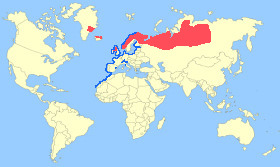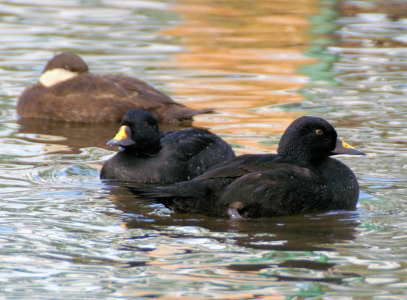Appearance:
Male - The male Common Scoter has an overall glossy black plumage, a distinctive greyish-black beak which is swollen at the base, with orange-yellow patch above, and black tip, a pointed black tail, and the legs and feet are greyish-black.
Female - The female has a sooty brown plumage with pale cheeks extending down the upper neck, and a greyish-black beak which is not swollen at the base or yellow like the male.
Size: - Typical Adult is 46-51cm (18-20in).
Food: - Mainly molluscs and crustaceans, mussels, small fish, fish eggs, aquatic insects, larvae also some algae and pondweed roots.
Habitat/Range: - Freshwater lakes, rivers, tundra, and woodland, wintering along the coast. Breeds in east Greenland, Iceland, northern UK, northern Europe, and northern Asia. Winters from UK and European coasts down to the west coast of Africa.

 Breeding Habitat/Resident,
Breeding Habitat/Resident,  Migration or Winter Area.
Migration or Winter Area.Breeding Season: - Late May to June.
Eggs: - 6 to 8 (pale-creamy or buff colour).
Notes: - The Common Scoter is a large sea duck which form large flocks over coastal waters during the winter. Numbers have rapidly declined in the UK probably due to oil spills, and predators such as the mink. The American Black Scoter is sometimes considered to be a sub-species of the Common Scoter.
Conservation status (IUCN 3.1):
Least Concern.
Classification: - Family: Anatidae,
Subfamily: Merginae, Genus: Melanitta.



 photo by Neill Smith.
photo by Neill Smith.
